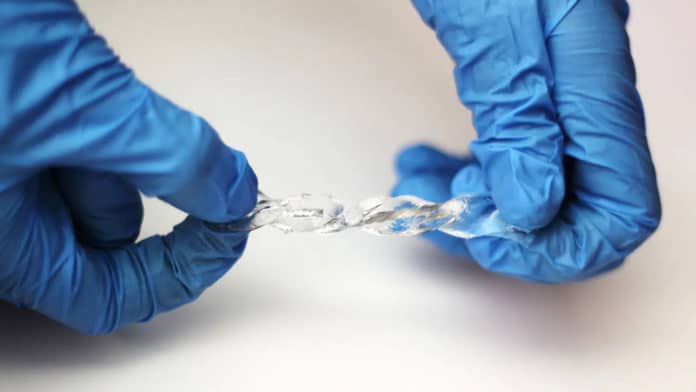Although there are already a number of devices that generate electricity through movement, most of them only work in dry environments. The new device is capable of working even underwater, which significantly expands the range of its potential applications.
Developed by the North Carolina State University researchers, the new soft and stretchable device converts movement into electricity and can work in wet environments. Electricity can be generated from the kinetic energy of wind, waves, body movement, and vibrations from motors.
The experimental energy harvester consists of a low toxicity liquid metal alloy core composed of gallium and indium encased within a stretchable, flexible strip of the hydrogel. Hydrogel is a biocompatible, water-swollen polymer (similar to contact lenses or Jello).
The water in the hydrogel contains dissolved salts called ions. The ions assemble at the surface of the metal, which can induce charge in the metal. When stretched, squished, or twisted, the surface area of the metal expands. This provides more surface to attract a charge, and its capacitance likewise increases, generating an electrical current. This current travels through an electrical wire connected to the device, allowing electricity to be used or stored.
“Since the device is soft, any mechanical motion can cause it to deform, including squishing, stretching, and twisting,” says Michael Dickey, corresponding author of a paper on the work. “This makes it versatile for harvesting mechanical energy. For example, the hydrogel is elastic enough to be stretched to five times its original length.”
In lab tests, researchers found that deforming the liquid-metal energy harvester by only a few millimeters generates a power density of approximately 0.5 milliwatts per meter squared. This amount of electricity is comparable to several popular classes of energy harvesting technologies, according to the researchers. However, unlike other energy harvesters, this one can work both completely immerged underwater or in otherwise wet conditions.
Researchers are now working to improve the technology’s efficiency. Also, they already have two related projects underway – one project is aimed at using the technology to power wearable devices by increasing the harvester’s power output, while the second project evaluates how this technology could be used to harvest wave power from the ocean.
